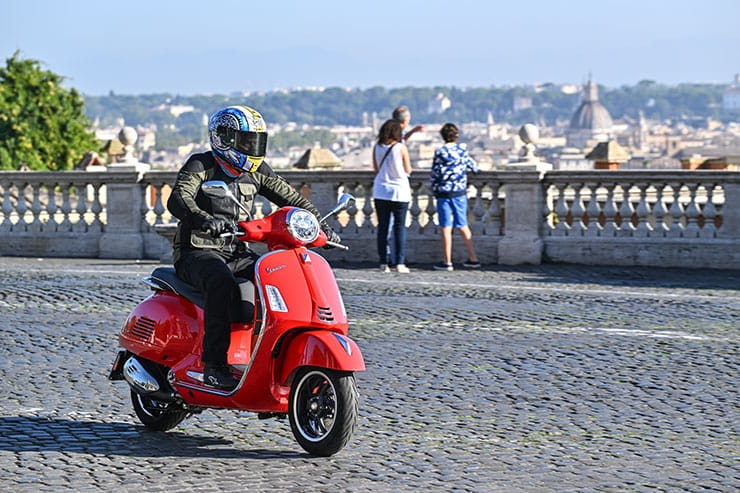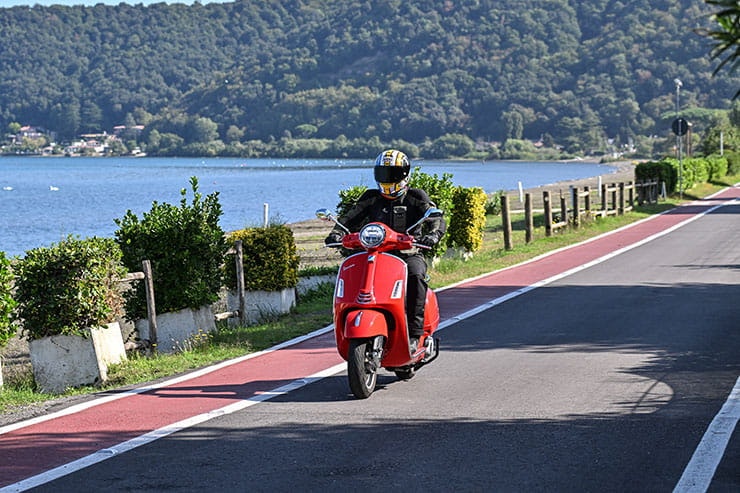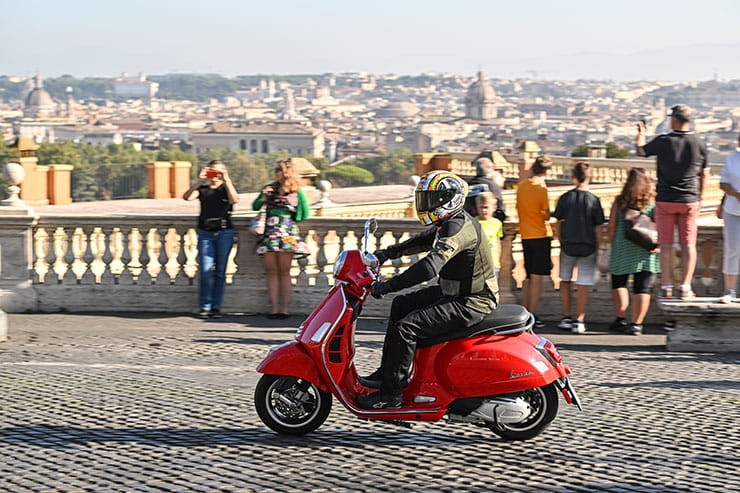Vespa GTS 300 (2023) - Review
BikeSocial Road Tester
23.11.2022
Price: £6,000 | Power: 23.8bhp | Weight: 155kg | Overall BikeSocial Rating: 4/5
Back in 2003 Vespa launched the G125 and 200, then in 2005 came the GTS 250 followed in 2016 by a 300cc GTS. Three years ago in 2018 came the introduction of the 23.8bhp HPE engine, making the larger GTS model the most powerful standard Vespa ever produced. The 21st century really has seen the Italian marque's iconic scooters grow ever bigger and faster in response to the demands of modern traffic conditions.
For 2023, Vespa has taken a slightly different turn and improved the style, safety, comfort, suspension, and brakes of its flagship GTS, while giving it an injection of new technology too
There are now four models to choose from – the base GTS, plus the Super, Super Sport and Super Tech – and, while the spec and style of each scoot are different, all feature the same proven chassis and HPE engine.
Vespa has stayed with a classical design on the standard GTS and Super, while opting for a slightly more modern take with the Super Sport and Super Tech. All four machines boast an improved quality of finish, pleasing new switchgear, new LED lights and neater fittings.
Vespa has also come up with a new dash and introduced a keyless system that operates both ignition switch and seat lock. Comfort has been enhanced with a new seat, which also allows shorter rides to feel more secure, despite the new bikes having the same 790mm seat height as before.
The traditional pressed-sheet steel frame remains, but now the single-sided front suspension has been updated for better stability and comfort. Braking has improved with new calipers, Brembo master cylinders and re-positioned levers. The Bosch ABS has also been refined.
Any Vespa update is big news among the scooter cognoscenti, and these new models represent a significant step for Vespa and its parent company Piaggio. So we grabbed the keyless fob to the classic-looking GTS Super and headed out into historical Rome for the day. Where better to test the new, Italian-built Vespa?
Retro styling
Improved ride quality and handling
More feel and quality
Expensive compared to Japanese competition
Lack of space under the seat
No parking brake, just centre stand.
Vespa GTS 300 PRICE
How much is the Vespa GTS 300 HPE? £6,000
(Super as tested: £6100. PCP: £89 x 37 months with £965.20 deposit)
The base GTS is priced at £6000, the tested Super at £6100, the Super Sport £6250, and Super Tech £6400. PCP for all four models is just £89 per month, with varying levels of deposits.
Just over £6000 or less than £90 a month does not appear to be a huge amount of money, especially in today’s market, but there are cheaper alternatives from Japan when you look across the market. Kawasaki’s J300 is over a thousand pounds cheaper at £4899. Yamaha’s XMAX 300 is £5950 and Honda's Forza 350 £5799.
Vespa GTS 300 Power and torque
In 2019 Vespa introduced the four-stroke 4v water-cooled 300 HPE (High-Performance Engine), the most powerful motor to be housed in a Vespa. The single-cylinder engine remains virtually unchanged, producing the same power and torque: 17.5kw/23.8hp at 8250rpm and 26Nm/19.2ftlb of torque at 5250rpm.
Fuelling is controlled by the latest generation Magneti Marelli MIUG4 ECU, with improved calculating capacity. Vespa has also tweaked the valve lift by changing the camshaft and added a new high-pressure multi-jet injector. These plus other small changes to the intake system improve torque at low speeds; make for easier, almost instantaneously start-up; and improve fuel consumption. Vespa quote 85mpg.
Engine, gearbox, and exhaust
Vespa aptly launched their new models in Rome, starting just a short journey away from the heart of the dramatic capital. With no clutch and very little lag – just twist and go – the GTS is as simple as it gets to ride a powered two-wheeler. The throttle connection is smooth, and you can ride along at walking pace with ease, without trailing your feet for stability.
There is power on tap: when you see a gap in the traffic or want to nip past a slow-moving bus, the 300 has a welcome zip of acceleration. Rome was, as expected, thoroughly congested but the Vespa carved up the traffic like it was born to the task. And, crucially, the HPE powerplant injects the GTS with enough drive from the lights to get in front of those frustrated cab drivers who race from every set of lights while dreaming of becoming Charles Leclerc.
I only managed to escape the congestion for an hour, but the four-stroke wasn’t outclassed on the open road. I’ve ridden the previous model, and the 2023 Vespa shares a very similar engine, with the same quoted power and torque. It will breeze up to 70mph – even 80mph in favourable conditions –while cruising at 70mph isn’t too much to ask.
Handling, suspension, and weight
Vespa wanted to improve the ride quality, comfort and handling of the new GTS, which resulted in a completely new single-sided front suspension unit. The new front fork gives the Vespa a different feel, with the strange ‘lift’ you sometimes get on the old forks all but eradicated. Now, the front feels more conventional; you don’t have the full dive of normal telescopic forks, but there is some familiar movement. They feel plush and soft over imperfections and are not as vague or rigid as the old system.
The rear setup has also been revised, again for the purpose comfort and handling. Combined with the new front you really feel the quality of the new set-up. Rome's cobbles, potholes and every imaginable surface in between were certainly a thorough test for the Vespa, and it truly shone. It dismissed cobbled surfaces that would shake some bikes to pieces and stayed serenely composed on the very worst the Italian capital could throw its way.
On the faster sections away from the centre of Rome, stability was excellent, with ground clearance not an issue in a busy urban environment. I loved the feel of the new front end, which filled me with confidence as the pace picked up and a city of frustrated F1 drivers got serious. It’s also nice to see Vespa hasn’t tried to save money on cheap rubber; the GTS's excellent Michelin City Grib should work equally well in the wet as they do in the dry.
But battling for position in the seething heart of Rome is where the Vespa is truly at home. The new, wide bars give more leverage, and you can flick the GTS 300 between FIAT Panda wing mirrors with absolute nonchalance, its 12-inch wheels and minimal 155kg making the steering almost weightless at urban speeds.
Vespa GTS 300 Comfort and economy
Following feedback from existing GTS owners, Vespa wanted to improve the comfort of the new 300, and this has been achieved with a new front end, revised rear settings, a new seat and a roomier riding position.
I only spent a single day on the new Vespa and comfort wasn’t once an issue. The bump-nullifying ride quality is seriously impressive, especially for a £6000 scooter, and certainly leaves you fresh after a dice with the traffic.
Despite new fuelling and small revisions to the engine, Vespa claims the same 85mpg as previously. With an 8.5-litre fuel tank accessed from under the seat, now via a keyless lock, the potential range is 190 miles. Some owners of the current GTS take on serious miles as cruising at 60-70mph isn’t a problem. But I think if I were going to use the Vespa for longer distances I’d fit the larger aftermarket screen.
Brakes
Vespa claims "a significant reduction in braking distances" thanks to new hydraulic master cylinders that are now Brembo items along with new brake calipers front and rear, with an updated Bosch system controlling the non-lean-sensitive ABS.
In response to customer demands, the front and rear levers – both mounted on the bars, of course – have been repositioned flatter, or less pointing upwards, and closer to the bars for riders with small hands, like me. It’s not a huge change, but instantly noticeable.
For the majority of the test I opted to use only the back brake, which is strong, progressive and all you really need at relatively low speeds. Over damp cobbles, you can feel the updated ABS working and, when you introduce the front, stopping power is strong and reassuring for a mid-capacity scooter, and the ABS is excellent. Add the GTS's lightweight and the control of its new front end and you’ll be surprised how quickly you can haul up the 300.
Rider aids, extra equipment and accessories
Despite its retro looks Vespa wanted to bring the 300 bang up to date in terms of technology. A new keyless system operates the ignition, seat and a small glove box up front containing a USB port and just enough room for a phone and spare gloves. VESPA MIA connectivity system comes as standard on the Super Sport and Super Tech or as an accessory for the standard GTS and Super as tested, should you wish to connect your phone. The Super Tech also gets a new TFT dash, which I think clashes slightly with the ‘classic-retro’ look of the Vespa. The other three models get a more traditional analogue speedo with a 3-Inch LCD display.
All models come with traction control as standard, which can be deactivated. Initially, I thought its inclusion was overkill but later felt the TC kick in when riding over wet cobbles. So maybe it is needed. It's certainly reassuring, as is the ABS, which can't be switched off.
According to Vespa there is enough room under the seat for two Vespa Visor 3.0 jet helmets, but it’s tight. If that isn't enough storage, Vespa offers a large 36-litre top box, which will accommodate a full-face helmet, and gives additional back support for a pillion. Front and rear luggage racks are available and, as expected, two optional screens (medium and high) can be grabbed from the official catalogue. Heated grips combined with a thermal leg cover will keep you toasty warm in winter and help make the GTS a versatile all-year bike. Vespa even offers alternative exhausts that sound a little fruitier than rather dull original, while a centre stand comes as standard, which you’ll need as there is no parking brake.
Vespa GTS 300 Rivals
Here’s a high-level comparison on the Vespa’s main competitors:
Kawasaki J300 | Price: £4,899
Power/Torque: 27.2bhp / 20.9 lb-ft | Weight: 191kg
Honda Forza 350 | Price: £5,799
Power/Torque: 28.8bhp / 23.2 lb-ft | Weight: 184kg
Yamaha XMAX 300 | Price: £5,950
Power/Torque 27.6bhp / 21.4 lb-ft | Weight: 183kg
Vespa GTS300 Verdict
If you want to ride Route 66 in the USA, then it really must be a Harley. For a track day at Mugello in Italy, then it has to be a Ducati or Aprilia. Commuting in Rome, meanwhile, requires nothing other than an Italian-made Vespa. On this test, I never once wished for another scooter.
Of course, the new bike’s qualities will shine in any city – Rome or Rotherham. The suspension and brakes are a significant improvement over the older model's. The ride quality on seriously dodgy road surfaces is sublime. And the new brakes are equally impressive. Vespa has really pulled its socks up because the new GTS exudes premium quality, with even details like its fasteners cleverly hidden.
In the flesh, I love the retro styling of the standard and Super versions especially – it's not often that you come across a scooter so visually appealing. Yes, the GTS is more expensive than the Japanese competition and doesn’t have the under-seat storage of some, but I can overlook a few niggles just because it looks so good and the ride quality is so excellent.
If you’re going to buy a scooter with your heart, it really has to be Vespa. The GTS made me smile every time I saw its reflection or gazed at it while sipping an espresso. The old 300 wasn’t a bad bike, but the ride quality, feel and uprated rider aids and technology of the new bike make it a serious contender for the best mid-capacity scooter on the market.
2023 Vespa GTS 300 - Technical Specification
Looking for motorbike insurance? Get a quote for this bike with Bennetts motorcycle insurance
What is MCIA Secured?
MCIA Secured gives bike buyers the chance to see just how much work a manufacturer has put into making their new investment as resistant to theft as possible.
As we all know, the more security you use, the less chance there is of your bike being stolen. In fact, based on research by Bennetts, using a disc lock makes your machine three times less likely to be stolen, while heavy duty kit can make it less likely to be stolen than a car. For reviews of the best security products, click here.
MCIA Secured gives motorcycles a rating out of five stars, based on the following being fitted to a new bike as standard:
A steering lock that meets the UNECE 62 standard
An ignition immobiliser system
A vehicle marking system
An alarm system
A vehicle tracking system with subscription
The higher the star rating, the better the security, so always ask your dealer what rating your bike has, and compare it to other machines on your shortlist.


